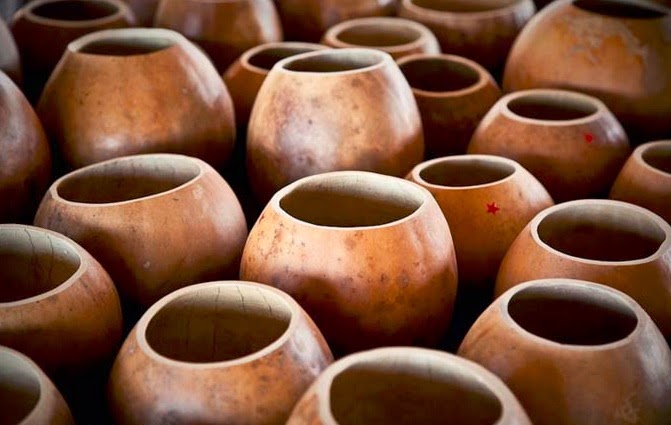Interestingly, this almost spherical vessel looks very much like a clay version of one of these:
And each one of these vessels is made of one these: a bottle gourd.
And gourd is what pre pottery, pre metal, pre glass people used for making vessels and utensils for handling cold liquids...Well people continued to use gourd for the same purpose even after pottery, metal and glass were invented. My grandparents had loads of things like these...
Now back to the original Dark faced burnished ware vessel. How was it made? Did people use a gourd vessel as a mould? Basically plastering the clay on the outside of the gourd vessel and then firing it all together? Gourd would combust leaving just a ceramic crust (pot)?
The oldest pots ever made were made in Asia, about 20,000 years ago. They look like someone plastered an inside of a basket and then fired the whole thing together. Basket burned away, leaving basket shaped and patterned vessel. I wrote about it in my post "Basket pottery":
So we know that Pre Pottery Neolithic Syrians knew how to make plaster, and that they possibly used some kind of basket mould for making their White ware vessels...So it is possible that eventually someone made a "plaster" that when accidentally burned turned hard and black...
What was the first product of this newly discovered technology was something like this. Selection of pots and bowls from Tell Sabi Abyad (ca. 6600-6200 B.C.), among the earliest pottery currently known from Syria...Again very sack, basket like, right?
What I find absolutely amazing, is that before people of Neolithic Syria discovered how to make proper clay pots, in the 8th millennium BC, they were making things like this: A bowl made from stone, calcite alabaster...From Met museum
This whole thing is a great example of two things:
1. How people "invent" by trying to imitate nature
2. How skill and technology are so very different.
Which brings me to the question: what should we use for judging cultural development? Aesthetics or technology? Because they don't always match...Just look at the last two pictures...








"Which brings me to the question: what should we use for judging cultural development? Aesthetics or technology?"
ReplyDeleteThat's a good question. Something to think about. Absolutely, people have always taken their cue from nature. It makes perfect sense that gourds or baskets would have been original foundations for what evolved into pottery.
Two other examples: in the Southwest, some tribes used pitch - either natural asphalt or pine pitch - to coat baskets and make them waterproof. The Tarahumara are perhaps best known for recent examples of that method, but surely European peoples did too. It would not take much of a leap to then coat the pitch with clay to prevent it from softening or melting in the heat when not in use.
Some years back I found a "dirt dauber wasp" construction that would have been a perfect clone for one of those tiny necked "seed pots" that Southwest Indian tribes made. It is perfectly round with a "neck that is thin and broadens out flat... that was the part the little wasp used to attach the (egg case?) to something. When the hatchling broke out, it made a hole in the side. The whole thing is smaller than a penny. I can give you a link to pictures if you would like.
Hi Tina. Thanks for your comment. I really think that all the technological advances were kind of logical and small...You see a nest with eggs. You think: this is cool. I can try to make something like this to hold things like acorns. You make an artificial nest. We know primitive granaries looks like artificial nests...Then eventually you make a basket. Then you plaster a basket. It makes it water and bugs proof. Then you burn the basket (accidentally). You end up with a pot...Small logical steps...All imitating nature...And I would love to see the pictures.
DeleteThank you for responding! I hadn't connected nests with baskets... of course! it makes perfect sense! Here's the link with the pictures: https://pecancorner.blogspot.com/2011/08/have-fairy-potters-been-in-my-garden.html
ReplyDeleteI learn something from every article you write. :-)